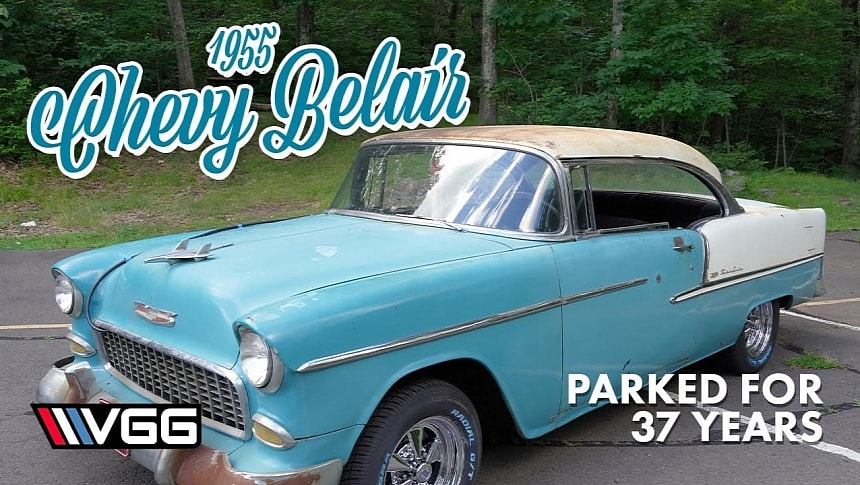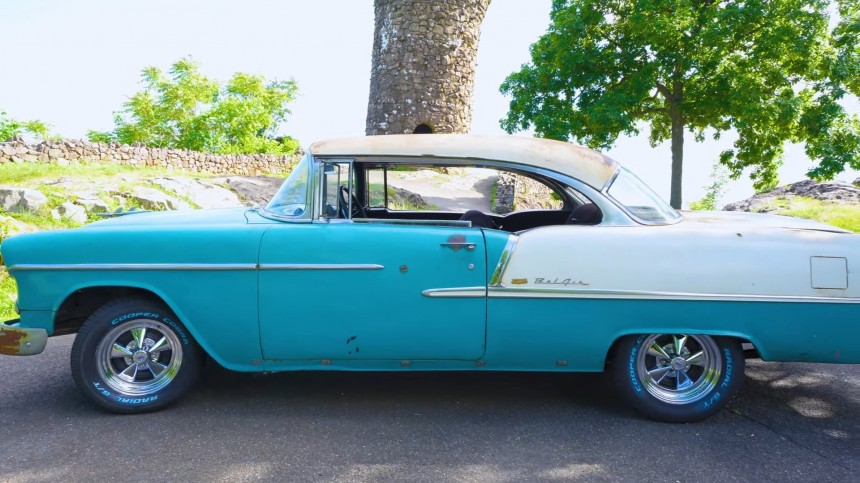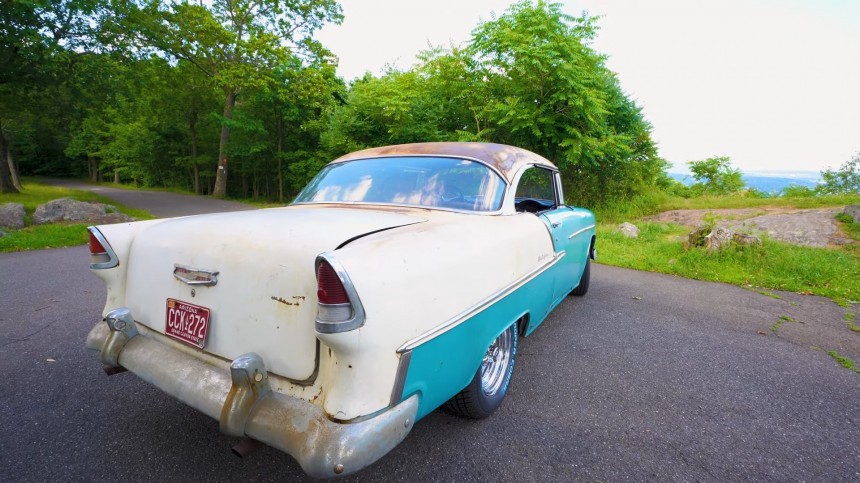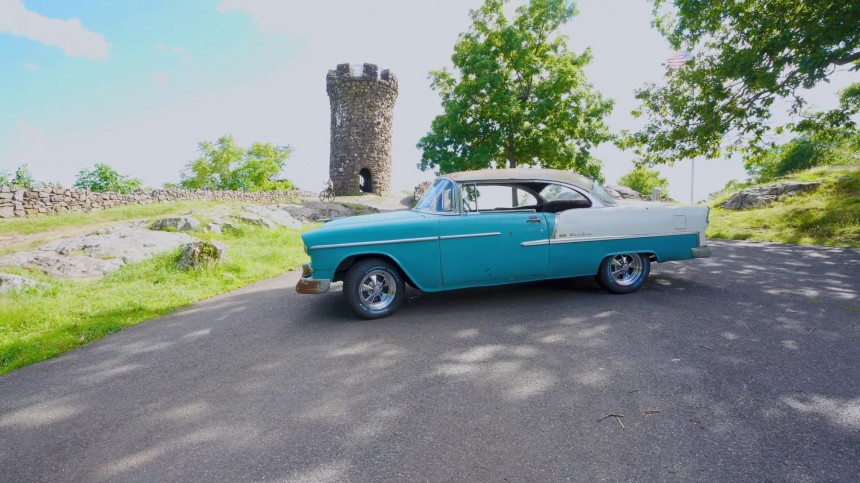Here’s one for each and every piston detective out there: how many 1955 Chevy Bel Air automobiles were built in total? Not in total in the United States of Automobile, but throughout the world. The first one to provide the correct number wins a virtual statue (horsepower-back, of course). Good luck to all of you Chevy loyalists. You had better have friends over in Mexico. Why is that? Because chances are you’ll need an insider who has some good info on those unicorns - the Mexican-assembled units.
That’s right, Canada wasn’t the only North American country where the Bel Air was produced outside its homeland. Some were made south of the Rio Negro – but the numbers (and pretty much all other details related to them) are second-hand info at best. The one certain thing is that those cars do exist – and the MX in their door jamb tag self-identifies as a genuine badge of provenance.
For some mysterious reason, the Southern neighboring country of the USA wasn’t very keen on following the strict General Motors protocols regarding production. Hence, Mexican Bel Airs might prove a challenge even for seasoned connoisseurs of the Bowtie icon.
The engines and transmissions will sometimes not correlate with the information conveyed in the trim tag and VIN; the colors might not follow the same pairing scheme as other manufacturing plants, and the list could go on.
Nonetheless, just because the body doesn’t wear a specific Chevrolet livery—or even a Chevy livery at all (sometimes, paints from other GM divisions were used)—doesn’t take away any merits from the Bel Airs assembled in Mexico.
They are every bit a Chevy legend as their siblings, who were born in the Land of The Free. Deep down, they were still American automobiles, and one of them got so homesick that it decided to cross the border and settle in the land of its parent corporation.
However, daring to live the American dream soon proved to be a nightmare lasting about 35 years. In 1987, the car somehow made it into the US (the exact method is unknown), and a gentleman bought it from Arizona. He sold it to a Connecticut man who wanted to get it back on the road (the car’s brakes didn’t work), but his two-car garage was already occupied. The Bel Air was the sacrificial offering strapped with a ‘For Sale’ sign on its window in 1989.
Fifteen long minutes passed since the car’s fate was made known to the neighborhood, and a teenager came knocking, waving a downpayment of a hundred bucks. The Bel Air had found a new owner – one from whom it never parted, but it never got much attention, either.
Well, until the man won a ‘Day with Derek’ raffle from Vice Grip Garage’s Derek Bieri, the car rescuer with a knack for old, abandoned, not working, and generally messed-up classic cars. This is where the fortunes of the Bel Air smiled upon its small-block V8.
The YouTuber agreed to fix the icon and return it to the road. The contest also meant that the winner would get $3,000 from the vlogger, plus a two-grand bonus in gift cards from a parts store and an extra $1,000 donation to a charity of the winner’s choice.
The car is back on the road after Derek's three-day effort and a lot of elbow grease (in the good old-fashioned tradition of Vice Grip Garage). The good news was that the motor, a 265 cubic-inch V8, was not seized, turned freely, and didn’t have any apparent issues. The venerable 4.2-liter had a major problem on its head– literally, the two-barrel carburetor was not carbureting properly (understandable since the car wasn’t touched in the last 35 years).
Luckily, a rebuild got it working again, leaving Derek the time to attend to the car’s other issues—like the gasoline and water pumps, the brake master cylinder, the radiator, the wheels, and finally, the brakes. He left out the fuel tank servicing, sticking to the tried-and-tested method of the ‘jug in the passenger seat’ fuel system.
The mystery surrounding this Mexican immigrant Bel Air still shrouds the 69-year-young automobile. For example, who would put a four-speed manual gearbox in it and why (none of the American car owners performed any restoration, repairs, or other work)?
Then there’s the matter of the paint job: the white-and-blue theme is a post-sale transformation – the Chevy originally had a pink main color (technically, it’s called Coral, but I’m not superstitious, and I prefer to call a color what it is). This unlikely unicorn was born with a three-speed manual, which is not there anymore.
A close-ratio four-speed is getting the car going, as shown in the video below (warning: it’s two hours and thirty-five minutes short). To call this car ‘rare’ would be like saying the sun is always switched on, except this Bel Air is rarer than a full solar eclipse. In 1955, Chevrolet promoted the Bel Air name to standalone model ranks, and it hit the jackpot: sales jumped off the charts.
In the U.S. alone, the 1955 Bel Air alone accounted for around 770,000 units, while the ‘210’ fared even better, with around 780,000 units on its name. The third model, the ‘150’, added another 130,000 units. The trio made Chevrolet the number one car brand in the USA, with 1.7 million examples sold, more than one-quarter-million cars above the runner-up Ford.
For some mysterious reason, the Southern neighboring country of the USA wasn’t very keen on following the strict General Motors protocols regarding production. Hence, Mexican Bel Airs might prove a challenge even for seasoned connoisseurs of the Bowtie icon.
The engines and transmissions will sometimes not correlate with the information conveyed in the trim tag and VIN; the colors might not follow the same pairing scheme as other manufacturing plants, and the list could go on.
They are every bit a Chevy legend as their siblings, who were born in the Land of The Free. Deep down, they were still American automobiles, and one of them got so homesick that it decided to cross the border and settle in the land of its parent corporation.
However, daring to live the American dream soon proved to be a nightmare lasting about 35 years. In 1987, the car somehow made it into the US (the exact method is unknown), and a gentleman bought it from Arizona. He sold it to a Connecticut man who wanted to get it back on the road (the car’s brakes didn’t work), but his two-car garage was already occupied. The Bel Air was the sacrificial offering strapped with a ‘For Sale’ sign on its window in 1989.
Well, until the man won a ‘Day with Derek’ raffle from Vice Grip Garage’s Derek Bieri, the car rescuer with a knack for old, abandoned, not working, and generally messed-up classic cars. This is where the fortunes of the Bel Air smiled upon its small-block V8.
The YouTuber agreed to fix the icon and return it to the road. The contest also meant that the winner would get $3,000 from the vlogger, plus a two-grand bonus in gift cards from a parts store and an extra $1,000 donation to a charity of the winner’s choice.
Luckily, a rebuild got it working again, leaving Derek the time to attend to the car’s other issues—like the gasoline and water pumps, the brake master cylinder, the radiator, the wheels, and finally, the brakes. He left out the fuel tank servicing, sticking to the tried-and-tested method of the ‘jug in the passenger seat’ fuel system.
The mystery surrounding this Mexican immigrant Bel Air still shrouds the 69-year-young automobile. For example, who would put a four-speed manual gearbox in it and why (none of the American car owners performed any restoration, repairs, or other work)?
A close-ratio four-speed is getting the car going, as shown in the video below (warning: it’s two hours and thirty-five minutes short). To call this car ‘rare’ would be like saying the sun is always switched on, except this Bel Air is rarer than a full solar eclipse. In 1955, Chevrolet promoted the Bel Air name to standalone model ranks, and it hit the jackpot: sales jumped off the charts.
In the U.S. alone, the 1955 Bel Air alone accounted for around 770,000 units, while the ‘210’ fared even better, with around 780,000 units on its name. The third model, the ‘150’, added another 130,000 units. The trio made Chevrolet the number one car brand in the USA, with 1.7 million examples sold, more than one-quarter-million cars above the runner-up Ford.









































